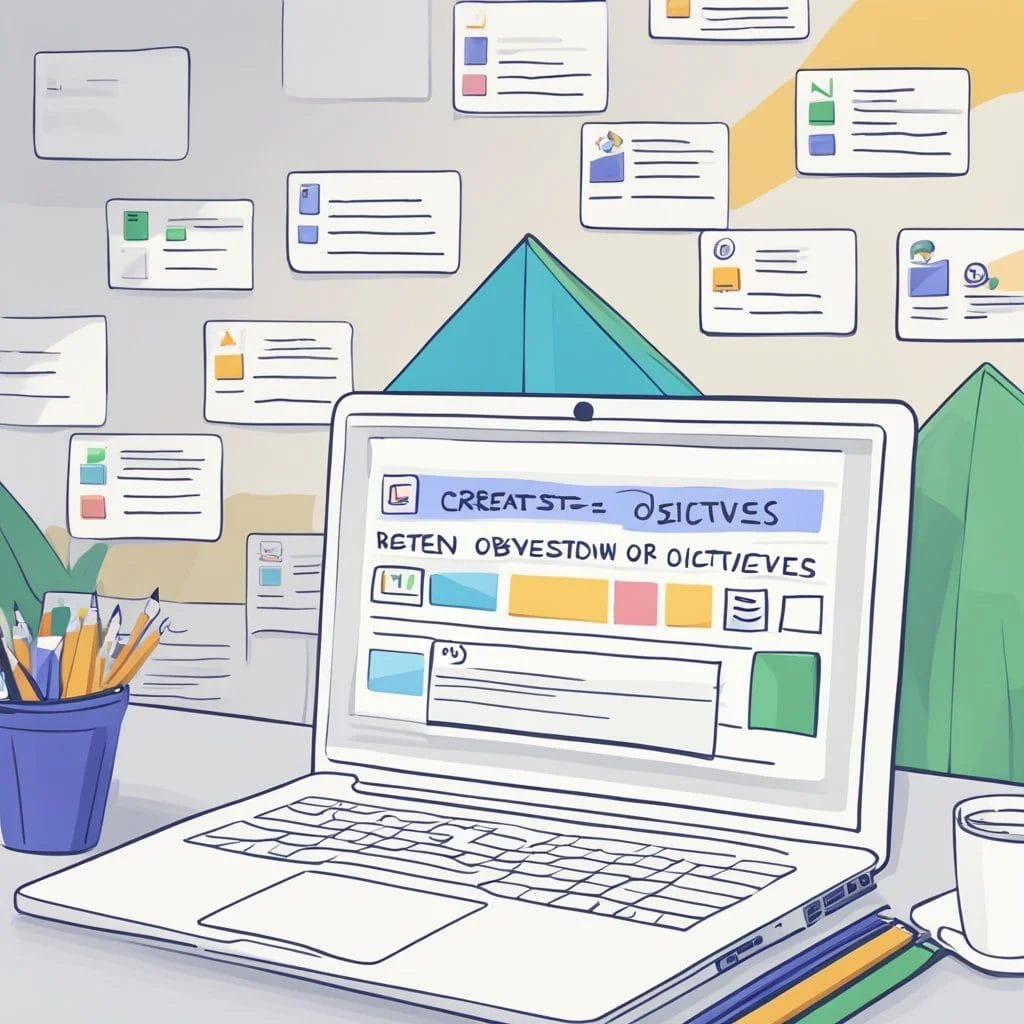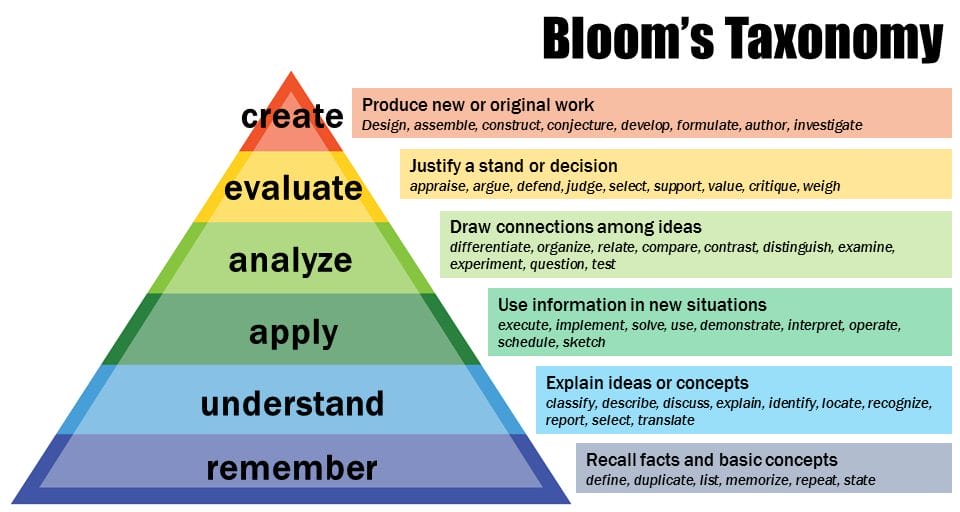How to Write Course Objectives and Learning Objectives (with Examples)
Are you a course creator or edupreneur learning how to write measurable learning objectives for your next online course?
Clear and effective course objectives help you and your students to know what to expect from the course and it is key to setting clear expectation for your students to demonstrate their understanding of the course.
KEY TAKEAWAYS
- Clear course objectives are crucial for both course creators and students, providing a roadmap for learning, guiding expectations, and serving as measurable milestones.
- Well-defined objectives keep the course focused, aid student understanding, contextualize content, and offer a framework, motivating learners by presenting clear targets.
- Craft measurable objectives by aligning them with course content, setting measurable criteria, using action verbs, incorporating Bloom’s Taxonomy, and addressing various learning domains.
What is a Course Objective?
A course objective or learning objectives are statements that outlines what you aim to teach and what your students are expected to learn.
Effective learning objectives need to be actionable and measurable, serving as milestones to direct both instruction and assessment throughout the course.
When writing objectives, consider them as promises to your students.
They detail the skills, knowledge, or attitudes they’ll gain upon course completion.
For instance, by the end of this course, you may expect students to be able to evaluate different art styles effectively or construct a basic web application.
How is Course Objective Different From Goal and Outcome?
A goal, an objective and an outcome can easily be confused.
The hierarchy of these 3 goes from,
- Goals > Objectives > Outcome
Course Goal
Course goals are broader and paint the big picture of your course or program. They encompass the overall course ethos and aim to shape the educational journey.
- Encapsulates the overarching skills the student will be learning.
- Knowledge students are expected to acquire during their academic journey.
For instance, a goal could focus on developing critical questioning and analysis skills or fostering an appreciation for ethical decision-making.
Course Objective
Course objective sets the stage for what’s to come, ultimately influencing the learning experience and enabling a focused, cohesive approach to teaching and learning online.
- More specific than goals, objectives are broader than student learning outcomes.
- Objectives articulate what students are expected to learn or achieve within the course, providing a roadmap for instruction.
Learning Outcome
Learning outcome provides a detailed description of what a student should be capable of at the conclusion of a course.
- Outcomes are specific, measurable, and often observable.
- Detailing conditions and acceptable performance levels.
Learning outcomes offer a clear picture of the expected achievements, facilitating both faculty and student understanding.
Why Course Objectives Matters For Effective Learning?

When you’re developing an online course, setting clear course objectives is pivotal.
Your objectives serve as a roadmap for your course, guiding both you and your students through the learning journey.
- Keep your course focused
- Ensure that students understand the goals they’re striving to achieve.
- Give context to the course material.
- Provide a framework for what is to come
- Offer a glimpse into the scope of the course.
By knowing what to expect, students can better organize their study time and resources, aligning their efforts with the desired outcomes.
Moreover, objectives motivate learners by establishing clear targets.
When you define what your students will learn, you’re not just presenting information; you’re promising a transformation.
These milestones are essential for keeping everyone organized and on track.
How to Write Course Objectives for Online Course

When creating an online course, clearly defined learning objectives are essential.
They orient your students and set clear expectations. Here’s a step-by-step guide to help you write learning objectives for your online course.
Step 1. Aligning Course Objectives with Course Content

When designing an online course, alignment between your learning objectives and course content is crucial.
Start with the end in mind.
This ensures that each piece of content contributes directly to the goals you’ve set for your students.
Ensuring Content Supports Goals
Start by defining your learning goals with precision, as these will guide the development of your course content.
Every video, reading, and activity included in your course should serve a specific purpose that maps back to these goals.
For instance, if one of your objectives is to improve critical thinking, include content that challenges students to analyze or evaluate information rather than simply recall facts.
By doing this, you make sure that your learning goals are the foundation upon which your course content is built.
Mapping Course Material to Objectives
With your course goals clearly specified, the next step is to create a course outline that lays out how each module or unit will help students achieve the desired learning outcomes.
Align your materials by matching content such as articles, lectures, and assignments to the corresponding objectives.
Consider using a table format to visually pair each objective with related course elements, ensuring a one-to-one relationship where possible.
This systematic approach not only strengthens the learning experience but also makes it transparent to learners how each component of the course helps them meet the objectives.
Step 2. Set Measurable Objectives That Define Your Subject and “By When”

When creating clear learning objectives, sharpen the focus by defining what students will accomplish and the timeframe for completion.
Each learning objective should clearly articulate what the student will learn and by when.
Setting Measurable Timeframe
Start your objective with a time-bound statement to set expectations. For example,
- “By the end of this lesson, you will be able to…”
- “By the end of this module, you will learn…”
- “By the end of this course, you will achieve…”
Setting Measurable Criteria
To determine if your students have mastered the content by the end of your course, frame your objectives with measurable terms.
Use action verbs like “list,” “describe,” or “construct,” which lend themselves to observable and quantifiable outcomes. Ask yourself:
- Are these activities demonstrable?
- Can these activities be evaluated?
Formulate learning objectives that are clear cut:
- Who will do the task?
- The student…
- What must be performed?
- Identify ten rules of grammar…
- How well should it be done?
- With 90% accuracy…
- By when must it be completed?
- By the end of the module…
Ensure that whether a student meets the objective is observable and measurable.
For example, if the objective is to “identify and label parts of a plant cell,” you should be able to witness the student completing this task and measure how accurately they do so against a clear standard, such as a scoring rubric.
Remember, each objective sets a milestone for your students.
By utilizing Bloom’s Taxonomy, craft your objectives to progressively build from simple recall to complex creation tasks.
Tailor assessments to these objectives to ensure alignment between what is taught and what is tested.
Step 3: Define Observable Action With Measurable Terms

Course and learning objectives should be written in a ways where you are able to clearly articulate what students will be able to do.
Objectives need to be written to specified in clear and measurable terms to ensures the outcomes are both observable and achievable.
Utilizing Bloom’s Taxonomy
Bloom’s Taxonomy provides a structured framework for categorizing educational goals.
- Bloom’s Taxonomy helps you specify levels of understanding
- Illustrate the progression from simple recall of facts to the creation of new ideas.
- Broken into six knowledge dimensions: Remembering, Understanding, Applying, Analyzing, Evaluating, and Creating
By aligning your learning objectives with this hierarchy, you ensure that each objective is measurable and clearly focused on the expected student action.
We will talk more about Bloom’s Taxonomy later in this article.
Choosing Action Verbs
Selecting the right action verbs from Bloom’s Taxonomy is crucial in framing your objectives.
Verbs like “list,” “describe,” and “construct” are tangible and verify that students have mastered the content.
Use these verbs to create objectives that outline what your students will accomplish, such as “Given a scenario, you will be able to calculate the outcome.”
Setting Observable Criteria
To confirm that objectives are met, they must be both observable and measurable.
This means defining how you will assess whether a student has achieved the objective.
For instance, if the objective is to “illustrate the steps in a process,” you will look for a detailed diagram from the student that captures all the necessary components.
Step 4. Incorporating Different Learning Domains

After you’ve all the foundation set, you should address the comprehensive areas of learning by including objectives across cognitive, affective, and psychomotor domains to create a well-rounded course.
Cognitive Domain
The Cognitive Domain involves mental skills and knowledge acquisition.
Bloom’s Taxonomy within this domain categorizes objectives from basic recall of facts, understanding, and application, to higher-order thinking such as analysis, evaluation, and creation.
When designing quizzes for your course, align them with these levels to assess a range of cognitive skills from memory to problem-solving.
Affective Domain
Objectives within the Affective Domain relate to emotions, attitudes, and feelings.
This domain’s progression moves from simple awareness and responsiveness to complex processes such as synthesizing values and controlling behavior accordingly.
Ensure your course objectives encourage students’ growth in areas such as motivation, attitude changes, and value adoption.
Psychomotor Domain
Lastly, the Psychomotor Domain involves physical ability and coordination.
Although less common in online courses, it’s still relevant for disciplines requiring manual or physical skills.
If applicable, include objectives that guide your students through observing demonstrations, practicing movements, and eventually mastering a physical skill.
Step 5. Implementing Course Objectives in Teaching Practices

After setting clear course objectives, the challenge is integrating them into your teaching methods effectively.
This ensures the learning experience is aligned with the intended outcomes.
Translating Objectives to Activities
To practically apply course objectives, create activities that embody the desired competencies.
To achieve excellence in learning and teaching, consider the the learning objectives for the end of the course, and emphasizes the connection between objectives and assessments.
For instance, if your objective is to improve critical thinking, design tasks that require analysis and evaluation.
By doing so, you’ll facilitate a more cohesive and directed online learning experience for your students.
Communicating Objectives to Students
Clearly communicate your goals and objectives through the learner’s perspective and make it student-centered can make your course more focused on the learner.
Convey the course objectives to your learners transparently.
- Start by outlining what they’re expected to learn.
- Talk about how it will be measured.
- Infuse this information within an introductory module, and reinforce it during teaching online.
- Discuss the relevance of these objectives within greater career or educational contexts, thereby highlighting their value beyond the course itself.
Describe the learning objectives and the learning outcomes of taking the course.
The center for teaching and learning studies stresses good communication skills will create a more successful teaching and learning ambience for the students, fostering a shared understanding between the instructor and the learner.
Bonus Step. Assessing and Revising Objectives

After setting your course objectives, the next important steps are to evaluate their effectiveness and make necessary adjustments.
This ongoing process is vital to the success of your online course.
Gathering Feedback on Objectives
To assess your course objectives, start by gathering feedback directly from your students.
- Use quick surveys or informal discussions to understand whether they find the objectives clear and attainable.
- Consider peer reviews from colleagues who can offer a different perspective on your model of learning objectives.
Gathering course objective feedback is crucial as it helps you determine if the objectives align with the overall course design and if students can demonstrate the intended outcomes.
Iterative Improvement of Objectives
Once you’ve gathered feedback, embrace an iterative approach to refine your course objectives.
Look at how well student performance matches your expectations; if there’s a gap, revisit and clarify your objectives.
Keep in mind that writing good learning objective is an ongoing process.
A well-written course objective may require several cycles of feedback and revision to create objectives that are both challenging and realistic for your students.
As you write and improve objectives, consider making them SMART
- Be specific, measurable, action-oriented, realistic, and time-bound.
This will ensure they serve as a solid framework to evaluate learning.
Examples For Writing Course Objectives

Yoga Course Example
Course Objectives
- Enhance Mind-Body Connection: By the end of this module, you will develop a heightened awareness of the mind-body connection through yoga practice, fostering a deeper understanding of the holistic benefits of yoga.
- Master Fundamental Asanas with Precision: Throughout this course, you will learn and execute fundamental yoga poses with precision, promoting physical strength, flexibility, and overall well-being.
- Cultivate Mindfulness and Stress Reduction: By engaging in mindfulness exercises and relaxation techniques, you will acquire the skills to manage stress and cultivate a sense of calm, promoting mental well-being both on and off the yoga mat.
Personal Finance Example
Course Objectives
- Achieve Financial Literacy: Over the duration of this course, you will gain comprehensive financial literacy, understanding key concepts such as budgeting, saving, investing, and debt management to make informed and responsible financial decisions.
- Develop Effective Budgeting Skills: By the end of this module, you will have mastered the art of budgeting, acquiring practical skills to create and maintain a personalized budget that aligns with your financial goals and priorities.
- Navigate Investment Strategies: Throughout the course, you will explore various investment strategies and vehicles, empowering you to make informed decisions to grow your wealth and secure your financial future.
Music Course Example
Course Objectives
- Master Musical Fundamentals: Over the course duration, you will acquire a solid foundation in music theory, enabling you to read sheet music, understand rhythm, and grasp key musical concepts essential for any aspiring musician.
- Develop Proficiency in Instrumental/Vocal Techniques: Through guided practice and instruction, you will hone your skills in playing a musical instrument or refining your vocal abilities, reaching a level of proficiency that allows you to express yourself confidently through music.
- Compose and Interpret Musical Pieces: By the end of this course, you will possess the skills to compose your musical pieces and interpret existing compositions, fostering creativity and a deeper appreciation for the art of music.
Using Bloom’s Taxonomy as a Framework for Writing Learning Objectives

When developing your online course objectives, consider Bloom’s Taxonomy as a guide. This well-established framework is divided into six cognitive skills from lower order thinking skills to higher order thinking skills:
- Remembering: Recalling facts.
- Understanding: Grasping the meaning.
- Applying: Using concepts in new situations.
- Analyzing: Breaking down information into parts.
- Evaluating: Critiquing and making judgements.
- Creating: Combining information to form a new whole.
Start each objective with a clear action verb correlating to these skills to ensure students know exactly what they will be able to do by the end of your course.
For example, if your aim is for students to recall knowledge, use verbs like “list” or “identify” for Remembering. For higher-order skills like Analyzing, incorporate verbs such as “compare” or “examine”.
Utilize the taxonomy’s knowledge dimensions to craft objectives that are not only specific and measurable but also aligned with the appropriate cognitive level.
- Make sure the desired outcomes are measurable through assessment.
- Avoid vague objectives changes according to interpretation.
- Be explicit about what students need to know, excluding the details of how they will be assessed.
For instance, if your course is introductory, you might emphasize Remembering and Understanding. In more advanced settings, Evaluating and Creating might be more relevant.
By thoughtfully choosing your verbs and aligning your objectives with Bloom’s Taxonomy, you’ll set a clear path for both teaching and assessing your course effectively.
- 7 Best Teachable Alternative for Course Creators (Free and Paid)
- LearnWorlds Features: In-Depth eLearning LMS Overview
- ThinkiFic Features: Course Creator’s In-Depth Overview
- +59 Best Proven Membership Site Ideas to Get Started This Year (Read First)
- Passion.io Review 2024: Still The Best App For Coaches & Creators? (Limited Time Lifetime Deal)
Join 900+ BUDDIES who are growing their wealth with our weekly Income Newsletter
Antony C. is a dividend investor with over 15+ years of investing experience. He’s also the book author of “Start Small, Dream Big“, certified PMP® holder and founder of IncomeBuddies.com (IB). At IB, he share his personal journey and expertise on growing passive income through dividend investing and building online business. Antony has been featured in global news outlet including Yahoo Finance, Nasdaq and Non Fiction Author Association (NFAA).


